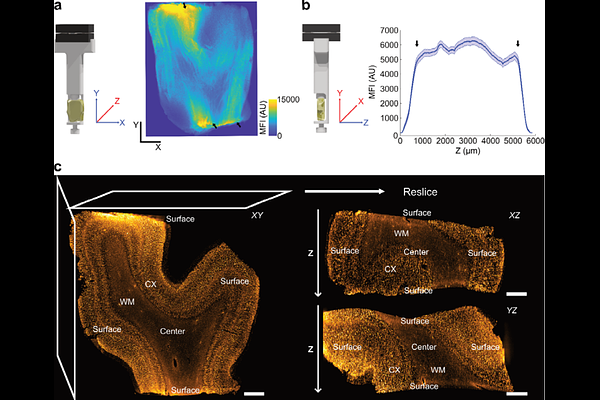aDISCO: A Broadly Applicable Method for 3D Microscopy of Archival Paraffin-Embedded Human Tissues

aDISCO: A Broadly Applicable Method for 3D Microscopy of Archival Paraffin-Embedded Human Tissues
Reuss, A. M.; Rupprecht, P.; Groos, D.; Cerisoli, M.; Nordberg, L.; Frick, L.; Voigt, F.; Vladimirov, N.; Bethge, P.; Reimann, R.; Helmchen, F.; Aguzzi, A.
AbstractDuring human surgeries and autopsies, specimens are regularly sampled and stored as formalin-fixed paraffin embedded (FFPE) tissue blocks. Diagnoses are rendered by microscopical examination of two-dimensional sections. Good clinical practice requires that samples be retained for decades, thus giving rise to enormous archives of healthy and diseased human tissues. Tissue-clearing technologies and whole-mount microscopy would enable 3D analyses, but whole FFPE tissue blocks are often unsuitable for clearing due to their size, their extensive covalent cross-linking, and their embedding in solid wax. Here, we present archival DISCO (aDISCO), a versatile and robust clearing method for whole-mount archival FFPE human tissue blocks. aDISCO enabled complete clearing and consistent antibody staining of samples stored for at least 15 years. We show that aDISCO can be applied to human brain, spinal cord, peripheral nerve, skin, muscle, heart, kidney, liver, spleen, colon, and lung, and is compatible with a wide range of commonly used antibodies. We applied aDISCO to the 3D study of focal cortical dysplasia (FCD), a neurodevelopmental disease associated with epilepsy. We performed deep-learning-based-segmentation and object detection to identify both focal and global neuronal density variations in FCD and to precisely quantify the disruption of cortical layering, features that are likely to be overlooked by conventional histology. When combined with selective-plane illumination microscopy, aDISCO delivers natively digital data suitable for deep-learning-based processing, thus enabling the detection of subtle and sparse pathologies in large archival human tissue specimens.